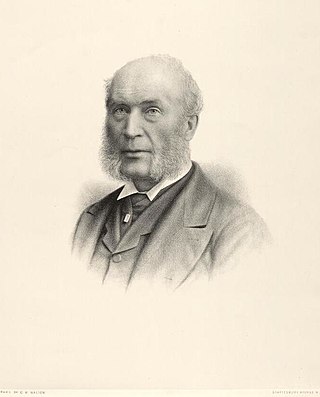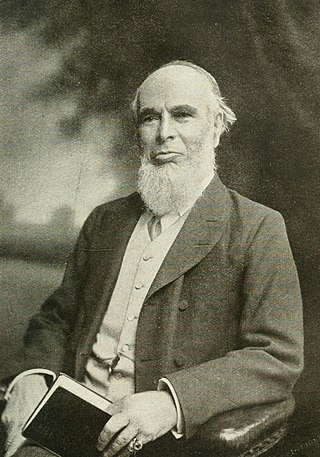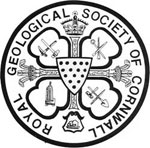
Penzance is a town, civil parish and port in the Penwith district of Cornwall, England, United Kingdom. It is the westernmost major town in Cornwall and is about 64 miles (103 km) west-southwest of Plymouth and 255 miles (410 km) west-southwest of London. Situated in the shelter of Mount's Bay, the town faces south-east onto the English Channel, is bordered to the west by the fishing port of Newlyn, to the north by the civil parish of Madron and to the east by the civil parish of Ludgvan. The civil parish includes the town of Newlyn and the villages of Mousehole, Paul, Gulval, and Heamoor. Granted various royal charters from 1512 onwards and incorporated on 9 May 1614, it has a population of 21,200.

Sir Warington Wilkinson Smyth was a British geologist.

Leonard Henry Courtney, 1st Baron Courtney of Penwith was a radical British politician, and an academic, who became famous after being advocate of proportional representation in Parliament and acting as an opponent of imperialism and militarism.

Sir Clement le Neve Foster was an English geologist and mineralogist.

Chacewater is a village and civil parish in Cornwall, England, UK. It is situated approximately 3 miles (4.8 km) east of Redruth. The hamlets of Carnhot, Cox Hill, Creegbrawse, Hale Mills, Jolly's Bottom, Salem, Saveock, Scorrier, Todpool, Twelveheads and Wheal Busy are in the parish. The electoral ward is called Chacewater & Kenwyn. At the 2011 census a population of 3,870 was quoted.
Sheriffs and high sheriffs of Cornwall: a chronological list:
Andrew Ketcham Barnett (1852–1914) was a mineral collector and dealer in Penzance, Cornwall, in the United Kingdom. He was Principal of the Penzance School of Mines, lectured on mining, and helped to build their mineral collection. He also served as Mayor of Penzance on seven occasions from 1906 to 1913.
Charles Fox was a Quaker scientist known for his contributions to Cornish mining. He also developed Trebah Garden, near Mawnan Smith in Cornwall. He was a member of the influential Fox family of Falmouth.

The Morrab Library is a subscription library in Penzance, Cornwall in England.

The Royal Cornwall Agricultural Show, usually called the Royal Cornwall Show, is an agricultural show organised by the Royal Cornwall Agricultural Association, which takes place at the beginning of June each year, at Wadebridge in north Cornwall, England, United Kingdom. The showground is on the south side of the A39 main road and between the hamlets of St Breock and Whitecross. The show lasts for three days and attracts approximately 120,000 visitors annually.
John St Aubyn, 1st Baron St Levan, known as Sir John St Aubyn, 2nd Baronet, from 1872 to 1887, was a British Liberal, and later Liberal Unionist, politician who sat in the House of Commons from 1858 until 1887 when he was raised to the peerage.

Sir Charles Lemon, 2nd Baronet was a British Member of Parliament for several constituencies and a baronet.
Henry Boase was a banker and writer from Cornwall, England.
Sir Arthur Edward Ian Montagu Russell, 6th Baronet was a British mineralogist. He was a collector and a collector of collections.

Joseph Henry Collins FGS, was a British mining engineer, mineralogist and geologist. He died at his home, Crinnis House, near St Austell, on 12 April 1916 and is buried in Campdowns cemetery, Charlestown.

Sir Arthur Pendarves Vivian was a British industrialist, mine-owner and Liberal politician from the Vivian family, who worked in South Wales and Cornwall, and sat in the House of Commons from 1868 to 1885.

John Hawkins was an English geologist, traveller and writer.

Howard Fox was a shipping agent and played a large part in the economic and cultural development of the town of Falmouth, Cornwall. He was a member of the influential Fox family of Falmouth.

Madron Well and Madron Well Chapel is a scheduled Ancient Monument in the civil parish of Madron, Cornwall, UK.
Rugby union in Cornwall is a timeline of rugby union in Cornwall in the 19th century.













